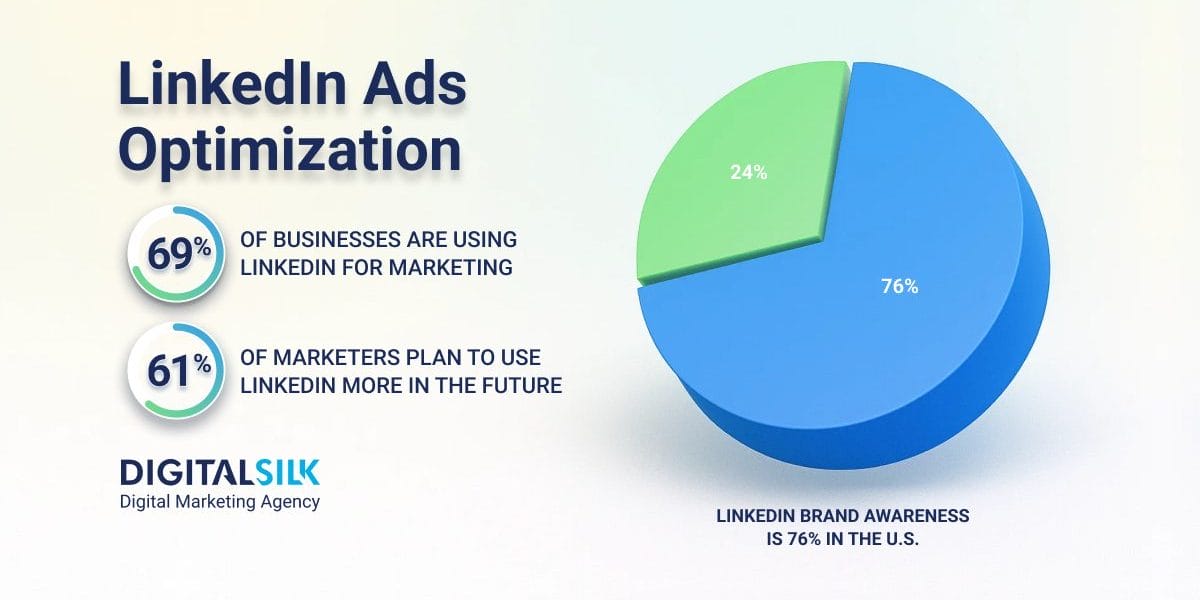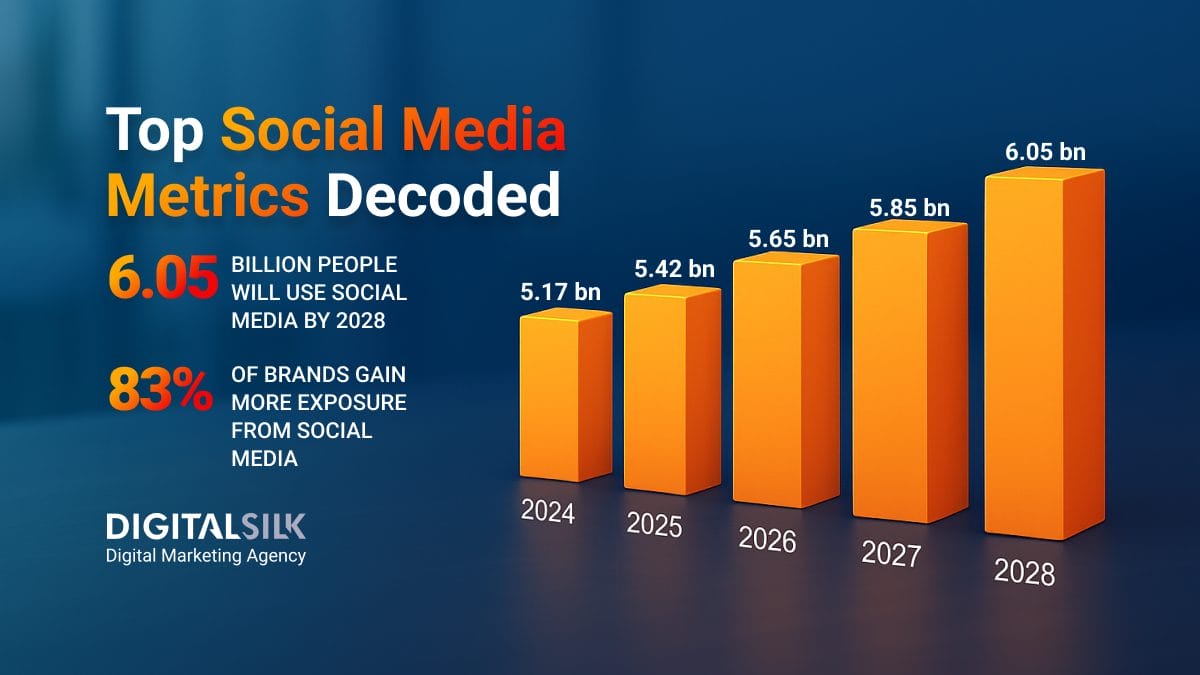LinkedIn Ads: Key Highlights
-
Ad selection defines how audiences engage: Choosing the right ad type ensures your message reaches the right people in the right format, from feed content to personalized inbox messages.
-
Sponsored Content builds trust through visibility: Appearing naturally in user feeds makes you a part of everyday professional conversations while driving qualified engagement.
-
Smart targeting improves conversion quality: Filtering by company size, seniority and intent focuses your marketing spending on audiences most aligned with your offer.
Every business owner knows that reaching the right people is half the battle.
With 270 million users in the U.S., the highest audience reach of any other country on LinkedIn, the platform offers direct access to industry leaders, investors and senior professionals who define strategy and accelerate growth.
Yet many brands still overlook how effectively its ad platform can turn visibility into qualified leads and long-term partnerships.
In this post, we’ll explore how to use LinkedIn ads to connect with high-value prospects, build authority and generate consistent revenue.
Common LinkedIn Ad Types And When To Use Them
When you advertise on LinkedIn, choosing the right ad type shapes how your message reaches and resonates with the audience you want to influence.
Brands that use LinkedIn ads effectively have seen purchase intent rise by 33%, showing how the right mix of formats can capture attention and convert interest into action.
Understanding the main types of LinkedIn ads and when to use them helps you create campaigns that align with your goals and reach the right audience:
1. Sponsored Content
Sponsored content is the foundation of LinkedIn marketing, appearing directly in the feed where professionals actively engage with ideas and opportunities.

When aligned with clear goals, sponsored content can build brand authority, expand reach and drive qualified engagement at every stage of the buyer journey.
Users typically see sponsored LinkedIn ads in one of the following formats:
Single Image Ads
Single image ads use one compelling image to deliver a message that’s easy to understand and act on.
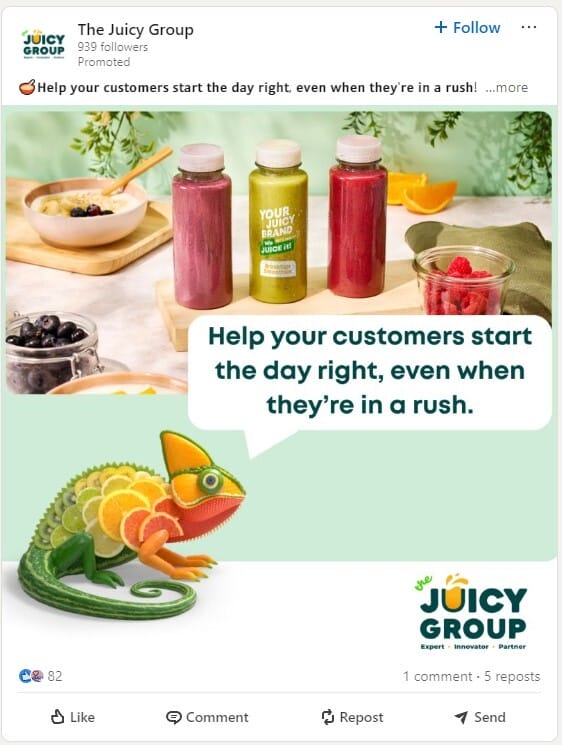
Some of the best practices when using this advertising format include:
- Use them for product launches, brand announcements or retargeting engaged audiences.
- Pair each ad with a distinctive image and concise copy that communicates a clear action or value.
- Recommended design specs: .jpg, .png, or .gif files up to 5 MB.
- Use image ratios of 1.91:1 (horizontal, desktop and mobile), 1:1 (square, desktop and mobile), or 1:1.91 (vertical, mobile only; 4:5 recommended for mobile).
- Aim for about 150 characters in the intro and 70 characters in the headline for readability.
Carousel Ads
Carousel ads invite audiences to engage by moving through a visual story that reveals more with each card.
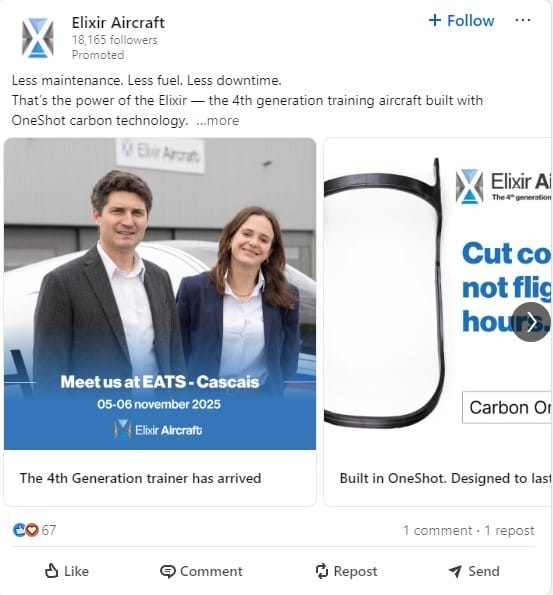
Follow these steps to make your carousel ads more effective:
- Combine 2–10 cards to guide viewers through features, results
,or a process. - Give each card its own headline and link to test different approaches within one campaign.
- Recommended specs: 1080 × 1080 px, up to 10 MB per card (.jpg or .png).
- Include introductory texts of up to 255 characters, with headlines of up to 45 characters.
Video Ads
Video ads use movement and sound to make messages more memorable and human.
You can make the most out of these formats by:
- Use short videos to share expertise, product demos or customer experiences.
- Include your logo and key message in the opening seconds since videos autoplay silently.
- Recommended specs: MP4 (AAC or MPEG4 audio), 3 seconds–30 minutes, ideally 15–30 seconds.
- Dimensions: 1:1, 16:9, 4:5, or 9:16; file size up to 500 MB.
Document Ads
Document ads give your audience direct access to valuable content they can read or download without leaving the feed.
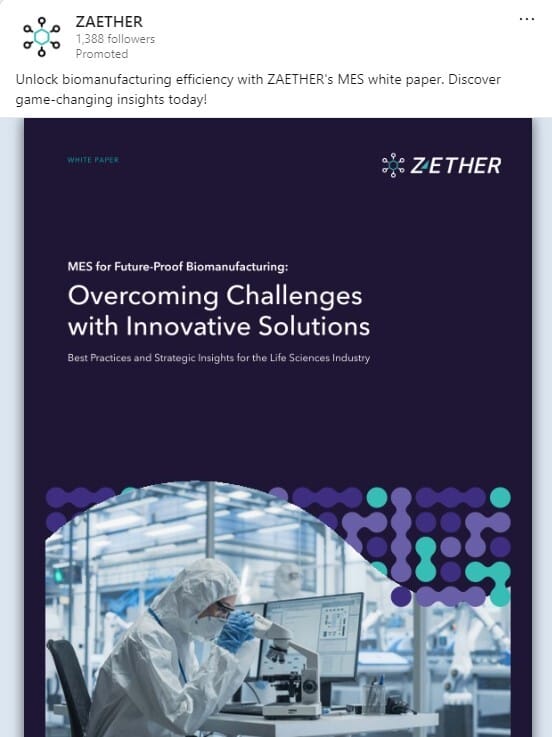
Follow these strategies to create effective document advertising campaigns:
- Share reports, templates or guides that demonstrate expertise and offer practical value.
- Choose between ungated access for reach or gated with a lead form for conversions.
- Supported formats: PDF, DOC, DOCX, PPT, PPTX; up to 100 MB.
- Keep documents under 10 pages for readability; maximum 300 pages total.
- Use relevant titles like “Checklist,” “Report,” or “Guide” that promise a clear takeaway.
Event Ads
Event ads highlight your live or virtual experiences and make it easy for audiences to participate.
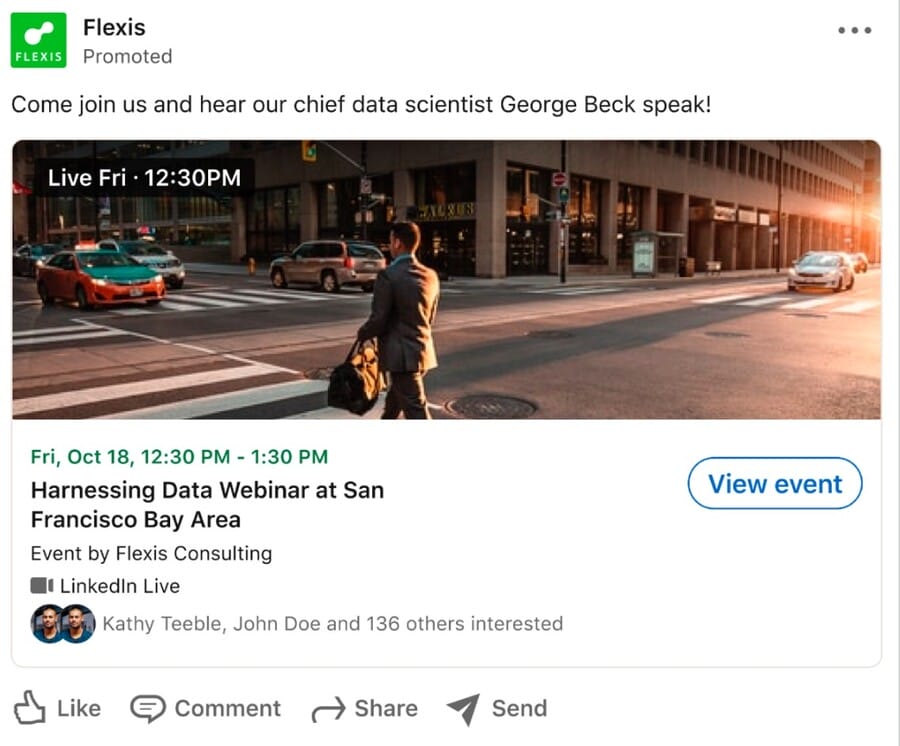
Some of the key best practices you can use include:
- Promoting webinars, launches or conferences directly within the feed to increase visibility.
- Running campaigns before, during and after events to sustain interest.
- Automatically pulling event details from your LinkedIn Event page for consistency.
- Image ratio: 4:1; intro text up to 600 characters; event name up to 255 characters.
- Retargeting attendees and viewers after the event to keep engagement active.
Thought Leadership Ads
The next ad format builds credibility by amplifying perspectives from trusted individuals within your company or network.

Follow these strategies to maximize results:
- Sponsor posts from executives, partners or experts to extend their reach.
- Focus on perspectives, stories and updates that align with your brand’s expertise.
- Formats include Single image, Video and Event posts.
- The author keeps ownership of the post, while your company gains added exposure.
- Campaign Manager tracks both organic and paid results in one place.
Article And Newsletter Ads
Continuing the list of available LinkedIn ad formats are article and newsletter posts that bring your long-form content to audiences who want depth and insight.

Use these best practices for newsletter and article ads:
- Use them to increase reads, grow subscribers and position your brand through expertise.
- Ads use the original post format and link directly to the Article or Newsletter page.
- Best for nurturing high-intent readers with perspectives that add lasting value.
- Matches single image ad specs for visuals and text.
Connected TV Ads
The final format reaches professional audiences through streaming platforms, combining LinkedIn’s first-party data with high-quality video placements to deliver brand stories in a focused, large-screen environment.
Here’s how you can use connected TV ads to your advantage:
- Deliver high-quality video ads on smart TVs and connected platforms using LinkedIn’s targeting data.
- Focus on brand storytelling, launches or awareness campaigns that benefit from visual impact.
- Recommended specs: 1920 × 1080 px, MP4 (H.264), 6–60 seconds, up to 500 MB.
- Retarget viewers later with in-feed ads to reinforce brand memory.
2. Sponsored Messaging
With more than 1.5 million pieces of content shared every minute on LinkedIn, getting your message seen requires a more intentional approach.
Sponsored Messaging lets you reach people directly in their LinkedIn inbox, which allows for timely and direct advertising on LinkedIn through communication that feels relevant to their professional interests.

How and when to use Sponsored Messaging effectively:
- Use Message Ads to send targeted messages with a single goal such as scheduling a demo, registering for an event, or promoting a limited offer.
- Choose Conversation Ads when you want to guide recipients through options using multiple calls to action that lead to specific resources or offers.
- Write messages that sound personal and purposeful, similar to how you would reach out in a professional setting.
- Limit frequency to keep your messages credible and avoid annoying users.
- Add Lead Gen Forms or clear calls to action so recipients can respond without leaving LinkedIn.
- Track engagement data to see which audiences and messages lead to higher-quality interactions.
3. Text Ads
Appearing on the right-hand sidebar or at the top of the desktop feed, Text Ads on LinkedIn help businesses reach professionals during active browsing moments without interrupting their experience.
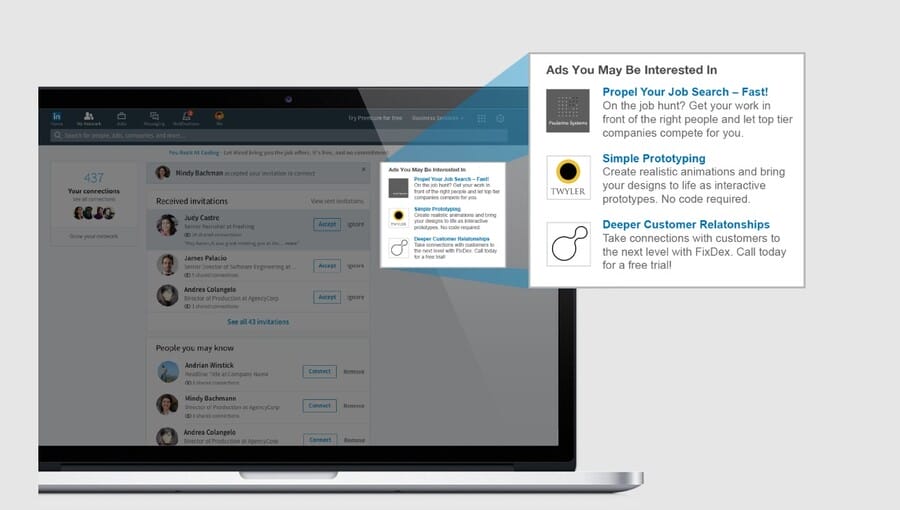
With 69% of marketers using LinkedIn, making it the third most popular social platform for marketing, these ads provide a cost-efficient way to increase visibility, test messaging and drive qualified traffic.
Use these strategies to apply this format properly:
- Use Text Ads to build awareness, retarget site visitors or direct traffic to a specific landing page.
- Write concise headlines that speak directly to your audience’s role or challenge, such as “IT Directors, Explore New Solutions.”
- Include a clear call to action like “Download the Guide” or “Book a Demo” to encourage response.
- Add a small image to draw attention, as people-focused visuals often perform better than logos.
- Link to a landing page that continues the message from your ad for a consistent experience.
- Run multiple ad versions to compare performance and refine both message and targeting.
- Check results every one to two weeks, replacing low-performing ads to maintain relevance and engagement.
- Choose between pay-per-click (PPC) or cost-per-impression (CPM) models based on whether your goal is lead generation or visibility.
4. Dynamic Ads
Dynamic Ads take personalization in advertising with LinkedIn to a new level by automatically adapting creative elements to each viewer’s profile.

These formats use member data such as name, photo, company and job title to make every impression more relevant while keeping personal information private.
They work best when the goal is to build recognition, promote offers or drive specific actions at scale without losing the personal touch.
Here are some ways you can maximize the performance of your dynamic ads:
- Use Follower Ads to grow your Company Page audience by inviting professionals to follow your brand directly from the ad.
- Choose Spotlight Ads to highlight a key initiative, offer, or resource that needs targeted visibility.
- Run Job Ads to promote open roles that align with a viewer’s skills and experience.
- Match the visuals and copy to your brand identity to make personalization feel intentional, not intrusive.
- Write short, direct copy that connects the personalized element (like company name or job title) to a clear next step.
- Test different creative variations to see which personalization triggers stronger engagement.
- Focus these campaigns on desktop, where Dynamic Ads display personalization most effectively.
Step-By-Step Guide To LinkedIn Advertising
With brand awareness at 76% in the U.S., LinkedIn is an effective channel that allows brands to connect with qualified buyers and industry leaders.
The step-by-step guide to LinkedIn ads below explains how to structure campaigns that align strategy, targeting and creative to drive measurable growth:
Step 1: Create Your LinkedIn Campaign Manager Account
With 21.6% of all internet users reachable through LinkedIn ads, how you set up your Campaign Manager account directly impacts the accuracy and performance of every campaign.
The details you establish at this stage, like the right company page, billing setup and user access, directly shape how each ad on LinkedIn performs and how easily your team can manage future campaigns.
From your homepage, click For Business at the top right corner and select Advertise to open Campaign Manager.
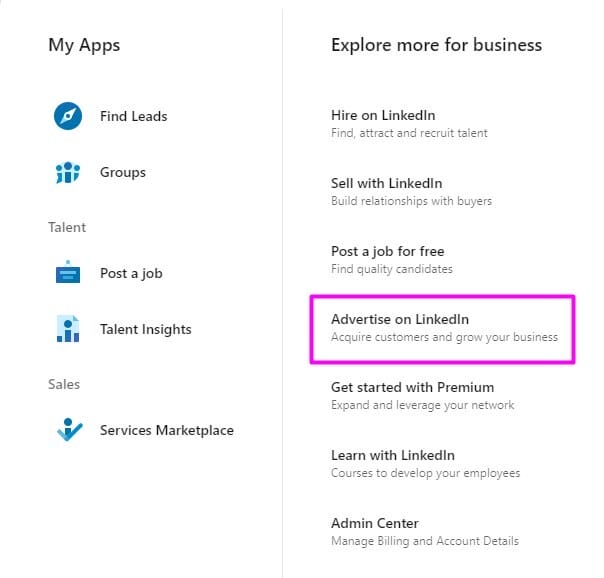
Then, take the following steps to set up your account:
- Click Create Account, then add an account name and choose your preferred billing currency.
- Select the Company Page you’ll advertise from. If you don’t have one, create a new Page within the setup flow.
- If your organization uses Business Manager, confirm you’re signed in under the correct account before continuing.
- Add your payment details in Account Settings > Billing > Add Payment Details.
- Assign access permissions for anyone who will manage or monitor campaigns in Account Settings > Manage Access.
Step 2: Choose A Campaign Objective
The objective you choose defines how your campaign will run, what ad formats you can use and how performance will be measured.
In LinkedIn paid advertising, this step tells the platform what you want to achieve so it can optimize delivery toward that outcome.
Selecting the right objective helps you direct your budget efficiently, access the most relevant creative options, and track results that align with your marketing goals.

Follow these steps to choose the right objective for your campaign:
- Decide what action you want your audience to take, such as visiting your website, engaging with content, or completing a form.
- Choose Awareness when you want to increase reach and visibility among target audiences.
- Select Consideration when your goal is to drive website visits, engagement, or video views from interested professionals.
- Use Conversion when you need measurable actions like lead submissions, sign-ups, or downloads.
- Match your objective with the ad formats that best support it, such as Sponsored Content for reach or Lead Gen Forms for conversions.
- Use LinkedIn’s built-in reporting tools to track progress against your chosen objective and forecast future performance.
Below, you’ll find an overview of the core objectives and recommended optimization strategies:
| OBJECTIVE | MARKETING GOAL | RECOMMENDED OPTIMIZATION | SUPPORTING AD FORMATS |
| Brand Awareness | Increase visibility and introduce your brand to new audiences. | Reach | Single Image, Document, Carousel, Video, Text, Dynamic AdS |
| Website Visits | Drive traffic to your website or landing pages for further engagement. | Landing page clicks | Single Image, Carousel, Video, Text, Dynamic Ads, Sponsored Messaging |
| Engagement | Encourage actions such as likes, comments, shares, and follows on your content. | Engagement clicks | Single Image, Document, Carousel, Video, Dynamic Ads |
| Video Views | Expand your video exposure and improve view duration among key audiences. | Video views | Video Ads |
| Lead Generation | Capture qualified leads using LinkedIn Lead Gen Forms with pre-filled profile data. | Qualified leads | Single Image, Document, Carousel, Video, Dynamic Ads, Sponsored Messaging |
| Website Conversions | Motivate audiences to complete valuable actions on your website such as downloads or sign-ups. | Website conversions | Single Image, Carousel, Video, Text, Dynamic Ads, Sponsored Messaging |
| Job Applicants | Motivate audiences to complete valuable actions on your website, such as downloads or sign-ups. | Landing page clicks | Single Image, Dynamic Ads |
| Talent Leads | Find potential candidates interested in your organization’s career opportunities (Recruiter contract required). | Talent leads | Dynamic Ads |
Step 3: Define Your Target Audience
Defining your audience is one of the most important parts of creating effective LinkedIn paid ads.
The more precisely you target, the higher the audience engagement you receive and the more relevant your message becomes.
With 33.4% of LinkedIn users aged 25–34, the platform offers a valuable mix of early and mid-career professionals who influence purchasing and strategic decisions.
Choosing the right combination of attributes and audience data helps your campaigns reach people who are most likely to respond and convert.
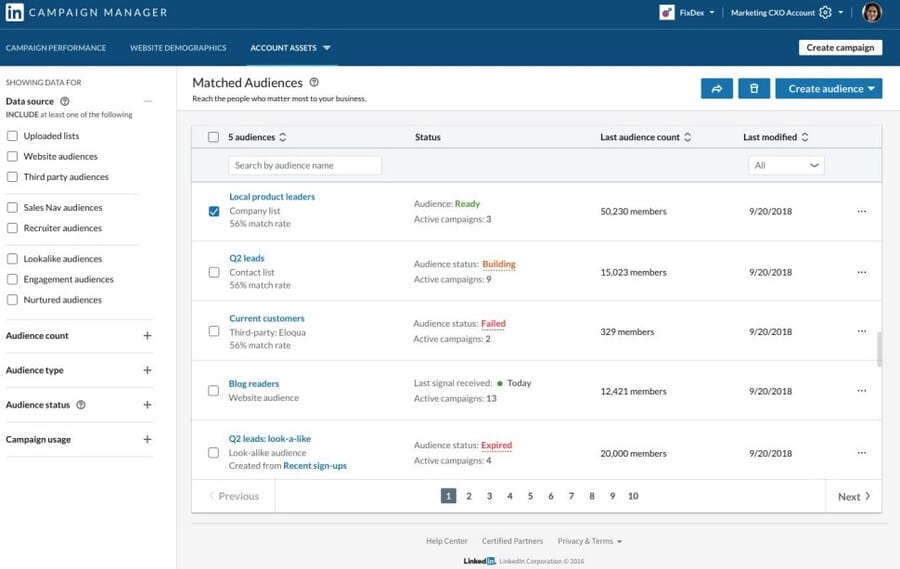
Use these steps to maximize audience targeting:
- Start by selecting core professional attributes such as industry, company size, job title, seniority and skills.
- Add Matched Audiences using CRM lists, website visitors or event registrants who have already engaged with your brand.
- Use Company Targeting to focus on organizations that align with your ideal client profile.
- Apply Contact Targeting to reach known leads or re-engage prospects with personalized campaigns.
- Include Retargeting to reconnect with people who viewed your videos, opened lead forms, or visited key web pages.
- Exclude existing customers, competitors and employees to maximize engagement.
- Experiment with different audience combinations to find the best balance between reach and conversion potential.
- Save high-performing audience segments to build lookalike lists for future campaigns.
Step 4: Set Up Your Ad Budget And Schedule
A clear budget and schedule determine how effectively your campaigns compete and the results you eventually achieve.
As 61% of marketers plan to increase their organic use of LinkedIn in the next 12 months, competition for attention and ad space will only grow.
Setting your budget intentionally ensures that your paid campaigns remain visible, adaptive and aligned with long-term marketing goals.
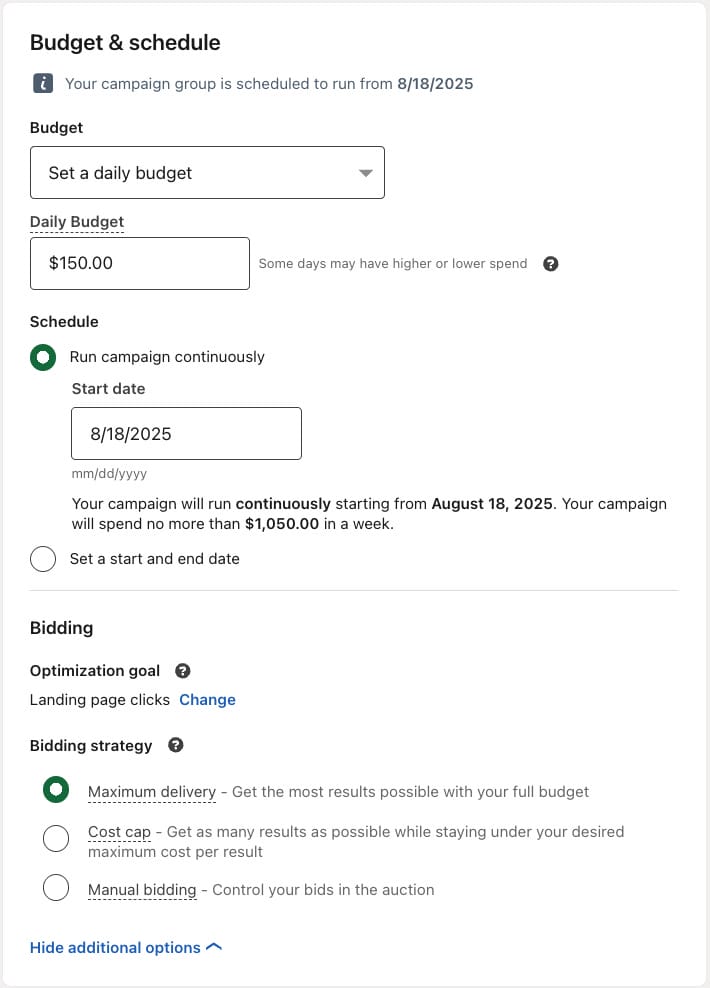
When setting up your campaign, consider the following budgeting options:
- Daily budget allows you to manage spend gradually and monitor performance trends before increasing investment.
- Total (lifetime) budget distributes funds evenly across the campaign period, ideal for fixed-duration or event-based efforts.
- Combined budgeting offers flexibility, giving you the ability to control daily pacing while maintaining an overall limit.
Some of the bidding models to support your goals include:
- Cost per Click (CPC) is suited for campaigns focused on generating leads, conversions, or website traffic.
- Cost per Impression (CPM) prioritizes visibility and brand awareness across your selected audience.
- Cost per Send (CPS) is used for Message Ads, where you pay per message successfully delivered.
Next, choose a bidding strategy that aligns with your marketing campaign:
- Maximum delivery automatically adjusts bids to achieve the highest results within your set budget.
- Cost cap helps control the average cost per result while still optimizing for performance.
- Manual bidding provides full control over bid amounts, allowing closer monitoring and refinement based on real-time data.
Finally, keep these scheduling best practices in mind when developing your strategy:
- Set defined start and end dates to align with reporting cycles and campaign objectives.
- Avoid changing campaign dates within 24 hours of launch to prevent delivery delays.
- Review pacing and performance during the first few days to ensure engagement and spending align with expectations.
- Reassess budgets periodically, shifting funds toward campaigns that deliver the most consistent results.
Step 5: Decide On Ad Formats And Optional Placements
Choosing the right format shapes how your audience experiences your message and how effectively your campaign performs.
In LinkedIn advertising, every format serves a different purpose, so the platform’s setup process allows you to preview performance estimates as you configure your campaign, helping you make informed, data-based decisions.
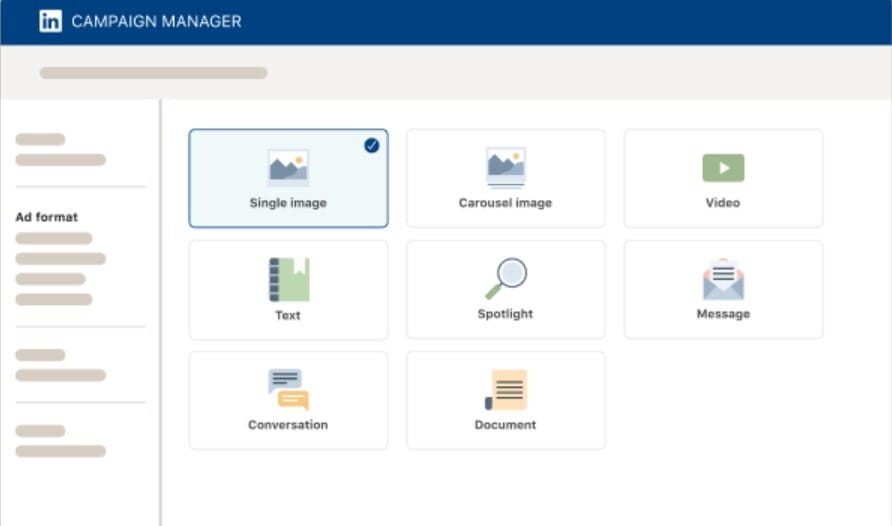
Here’s how you can set up and choose your ad formats:
- Begin by confirming your campaign objective and target audience, since available formats are automatically filtered based on those choices.
- Use the Forecasted Results panel in Campaign Manager to review expected reach, engagement, and conversions for each format.
- Factor in your budget and creative assets, as some formats require more production time or visual design than others.
- Match your message intent to the format’s strength. For example, use more interactive options for awareness campaigns and focused formats for conversion goals.
- Link your Company Page when required to ensure proper delivery and engagement tracking.
- Decide whether to activate Audience Network placements to extend your reach to trusted partner sites and apps outside of LinkedIn.
- Preview how your ads will appear on both desktop and mobile to confirm that visuals and messaging remain consistent.
Step 6: Add URL Parameters For Tracking
With 38% of marketers saying LinkedIn generates the most leads, tracking how those leads are created is essential to refining your campaigns.
URL parameters make it possible to see exactly which ads, audiences and formats drive engagement and conversions.
By connecting these insights to your analytics tools, you gain a clear view of what delivers value and where to focus your spending efforts in the future.
Here’s how you can set up URL parameters in LinkedIn ads:
- Add tracking parameters to the end of each destination URL to identify the campaign or ad that drove the visit.
- Use static parameters for fixed labels like campaign names and dynamic parameters to automatically pull in variable data from Campaign Manager.
- Enter parameter keys and values under the Tracking section (for example, utm_source=linkedin or utm_campaign=lead_generation_q2).
- Keep your naming structure consistent across campaigns to simplify analysis in tools such as GA4 or HubSpot.
- Test all links before launch to confirm that parameters function correctly and landing pages load as intended.
Step 7: Set Up Conversion Tracking
Conversion tracking shows what happens after someone interacts with your ad, whether they filled out a form, downloaded a resource or made direct contact with your company.
Setting it up allows you to see how each campaign contributes to your goals and where to apply future improvements.
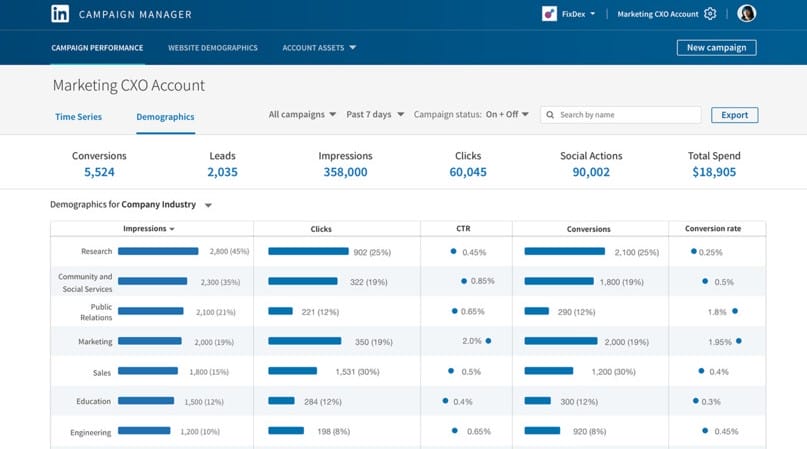
The main ways to track conversions include:
- Website Tag (Insight Tag): Add this lightweight code to your site to capture actions like visits, downloads, or button clicks.
- Imported Conversions: Upload data from offline channels such as phone calls, meetings, or CRM systems to link real-world actions to campaigns.
- Conversions API: Integrate your CRM or marketing tools to automatically send conversion data to Campaign Manager for continuous tracking.
Follow these steps to complete your setup:
- In Campaign Manager, open the Conversions section and select Create Conversion.
- Name your conversion clearly to match the action you want to measure, like “Contact Form Submission” or “Whitepaper Download.”
- Select the appropriate tracking method and assign it to the relevant campaigns.
- Define the exact event that counts as a conversion, such as landing on a confirmation page or submitting a form.
- Verify that your tags, uploads or integrations are active and capturing data correctly before launching your campaign.
Apply these best practices for accurate results:
- Combine multiple tracking methods to get a complete view of how users move from ad engagement to conversion.
- Check your conversion data regularly to identify trends and adjust campaigns based on real outcomes.
- Maintain clear naming conventions and consistent organization across campaigns to make data easier to analyze as your advertising scales.
Step 8: Create And Optimize Your LinkedIn Ads
The way you craft and refine each ad determines how your audience experiences your message and whether they take action.
In advertising on LinkedIn, every word, image, and call to action plays a role in building credibility and driving measurable engagement.
Taking the time to plan, test and adjust your creative ensures that your campaigns communicate value clearly and consistently.
When creating your ads, focus on these elements:
- Introductory text: Write a concise opening that speaks directly to your audience’s priorities and makes the value clear from the first line.
- Headline: Use a clear, benefit-driven statement that reinforces your core message and encourages action.
- Description: Add supporting context where applicable, keeping it brief and relevant to the main idea.
- Media: Choose visuals that represent your message accurately and maintain consistency with your brand identity.
- Destination URL: Link to a page that continues the ad’s message and aligns with the audience’s intent.
Digital Silk’s LinkedIn Advertising Example
Digital Silk helped AGS Devices turn LinkedIn into a high-performing channel for lead generation and brand awareness.
Our team launched targeted campaigns aimed at decision-makers in aerospace, industrial and healthcare manufacturing, using precise filters such as industry, job function and company size.
The ad creative highlighted AGS’s key strengths in verified inventory, responsiveness and reliability, supported by consistent organic content that built trust and engagement.
Within weeks, our marketing efforts lowered cost per lead by 48% and expanded account reach by more than 3,800%, firmly positioning AGS as a credible leader in its field.
How To Measure Your LinkedIn Ads’ Performance
Evaluating performance regularly helps you refine targeting, improve creative and ensure your budget is driving results that actually matter:
| METRIC | WHAT IT MEANS |
| Impressions | Show how many times your ads were displayed, helping you gauge reach and visibility within your target audience. |
| Click-through rate (CTR) | Indicates how many viewers engaged with your ad by clicking, offering insight into message relevance and audience interest. |
| Conversion rate | Measures how many clicks led to valuable actions such as downloads, sign-ups, or form submissions, showing how effectively your ads turn attention into outcomes. |
| Cost per click (CPC) | Tracks the average amount spent for each click, helping you evaluate cost efficiency across campaigns. |
| Cost per conversion (CPA) | Shows how much you’re spending to achieve each desired action, a key indicator of overall campaign profitability. |
| Engagement rate | Combines reactions, comments, and shares to reflect how well your content resonates with your audience. |
| Return on ad spend (ROAS) | Calculates the revenue generated for every dollar spent, offering a clear view of the campaign’s financial impact. |
Monitoring these metrics helps you understand what’s driving your results and where adjustments are needed, ensuring your LinkedIn ad strategy remains effective and cost-efficient.
Why Advertising On LinkedIn Matters For Businesses
LinkedIn has become a central platform for organizations that want to reach professionals with genuine intent and purchasing influence.
Using LinkedIn advertising services offers the following benefits for businesses:
- High-value audience access: LinkedIn’s audience has 2x the buying power of the average web audience, giving businesses access to professionals who have real authority over purchasing decisions.
- Trusted environment for business growth: Members come to LinkedIn to exchange ideas, explore partnerships, and evaluate solutions, creating a setting where advertising feels relevant rather than intrusive.
- Marketing relevance and recognition: 29% of marketers rank LinkedIn as the second most important social media platform for achieving meaningful business results.
- Comprehensive targeting capabilities: Campaigns can target audiences by company size, industry, function, or seniority, ensuring that ads reach people most aligned with business objectives.
- Proven results across industries: Brands across sectors use LinkedIn to generate qualified leads, build authority, and foster long-term relationships with high-value clients.
- Direct alignment with business goals: Advertising on LinkedIn helps companies link campaign performance to measurable outcomes, turning marketing efforts into meaningful business growth.
Optimize Your LinkedIn Ads With Digital Silk
Optimizing campaigns on LinkedIn calls for an understanding of how professionals connect, evaluate, and act within a business context.
Every ad becomes an opportunity to build credibility, inspire brand awareness and grow your core audience.
Digital Silk can help brands create tailored strategies, design impactful campaigns, and transform engagement into long-term growth.
As a full-service digital marketing agency, we offer:
- Data-driven marketing campaigns
- Social media marketing
- PPC management
- SEO services
- Branding solutions
- Custom web design
Contact our team, call us at (800) 206-9413 or fill in the Request a Quote form below to schedule a consultation.
"*" indicates required fields


